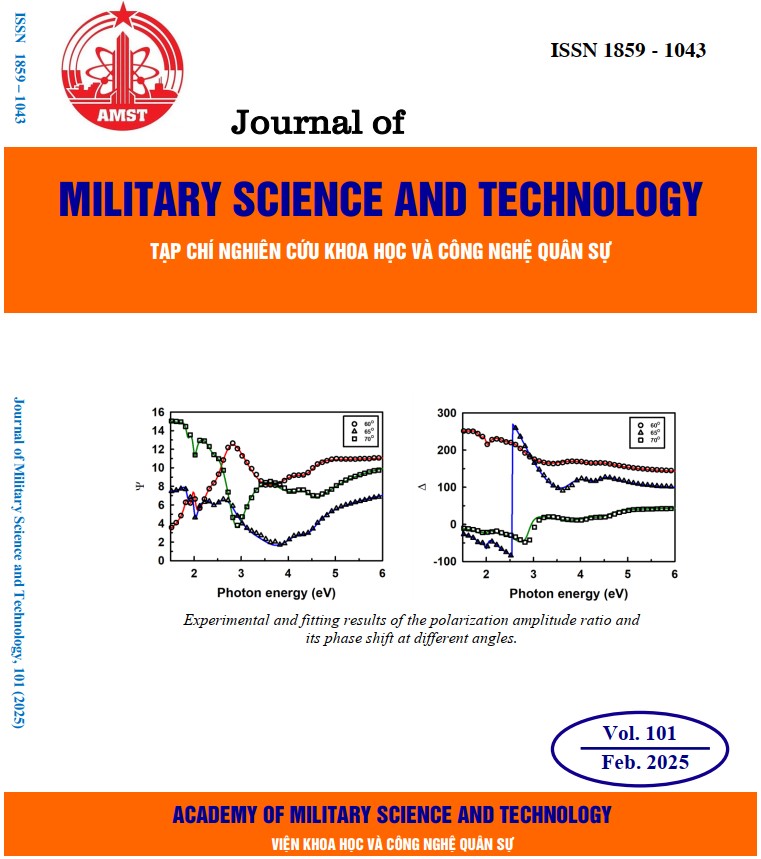Solution for suppressing viscoelastic creep in cylindrical dielectric elastomer actuator
344 viewsDOI:
https://doi.org/10.54939/1859-1043.j.mst.101.2025.148-154Keywords:
Cylindrical dielectric elastomer actuator; Viscoelastic creep; Creep compensation.Abstract
The cylindrical dielectric elastomer actuator (CDEA) is known as a self-prestretching structure of dielectric elastomer actuators (DEAs). However, their inherent viscoelastic nonlinearity leads to nonlinear viscoelastic creep and hysteresis, which makes the modeling and control of CDEAs challenging and can affect their motion accuracy in practical applications. In this paper, the generalized KV-GM rheological model is employed to characterize the actuator's viscoelastic creep behavior, and an adjusted voltage signal is derived from maintaining a constant output stretch by making the input voltage time-dependent. Experimental results with the preprogrammed voltage demonstrate that the creep rate of the CDEA decreases from 27% to less than 9%. The proposed solution effectively minimizes energy dissipation caused by nonlinear viscoelastic properties, playing a significant role in promoting the practical application of CDEA.
References
[1]. Pei, Q., Pelrine, R., Stanford, S., Kornbluh, R., & Rosenthal, M. “Electroelastomer rolls and their application for biomimetic walking robots”. Synthetic Metals. 135, 129-131, (2003). DOI: https://doi.org/10.1016/S0379-6779(02)00535-0
[2]. O’Halloran, A., O’malley, F., & McHugh, P. “A review on dielectric elastomer actuators, technology, applications, and challenges”. Journal of Applied Physics. 104(7) 9, (2008). DOI: https://doi.org/10.1063/1.2981642
[3]. Carpi, F., Kornbluh, R., Sommer-Larsen, P., De Rossi, D., & Alici, G. “Guest editorial introduction to the focused section on electroactive polymer mechatronics”. IEEE/ASME Transactions on Mecha-tronics. 16(1), 1-8, (2010). DOI: https://doi.org/10.1109/TMECH.2010.2094199
[4]. Liu, L., Liu, Y., & Leng, J. “Theory progress and applications of dielectric elastomers”. International Journal of Smart and Nano Materials. 4(3), 199-209, (2013). DOI: https://doi.org/10.1080/19475411.2013.846281
[5]. Bar-Cohen, Y. “Electroactive polymer (EAP) actuators as artificial muscles: reality, potential, and challenges”. SPIE press. 136, (2004). DOI: https://doi.org/10.1117/3.547465
[6]. Pelrine, R., Sommer-Larsen, P., Kornbluh, R. D., Heydt, R., Kofod, G., Pei, Q., & Gravesen, P. “Appli-cations of dielectric elastomer actuators. Smart Structures and Materials. Electroactive Polymer Ac-tuators and Devices”. International Society for Optics and Photonics. 4329, 335-349, (2001). DOI: https://doi.org/10.1117/12.432665
[7]. Löwe, C., Zhang, X., & Kovacs, G. “Dielectric elastomers in actuator technology”. Advanced engi-neering materials. 7(5) 361-367, (2005). DOI: https://doi.org/10.1002/adem.200500066
[8]. G. Kovacs, P. Lochmatter, M. Wissler, “An arm wrestling robot driven by dielectric elastomer actua-tors”. Smart Mater. Struct. 16(2), S306, (2007). DOI: https://doi.org/10.1088/0964-1726/16/2/S16
[9]. R. Pelrine, R.D. Kornbluh, Q. Pei, S. Stanford, S. Oh, J. Eckerle, K. Meijer. “Dielectric elastomer arti-ficial muscle actuators: toward biomimetic motion”. Smart Structures and Materials 2002: Electroac-tive Polymer Actuators and Devices (EAPAD), vol. 4695, pp. 126–137, (2002). DOI: https://doi.org/10.1117/12.475157
[10]. Q. Pei, R. Pelrine, S. Stanford, R.D. Kornbluh, M.S. Rosenthal, K. Meijer, R.J. Full. “Multifunctional electroelastomer rolls and their application for biomimetic walking robots”. Smart Structures and Materials 2002: Industrial and Commercial Applications of Smart Structures Technologies, vol. 4698, pp. 246–253, (2002). DOI: https://doi.org/10.1117/12.475071
[11]. G.K. Lau, H.T. Lim, J.Y. Teo, Y.W. Chin, “Lightweight mechanical amplifiers for rolled dielectric elastomer actuators and their integration with bio-inspired wing flappers”. Smart Mater Struct. 23(2), 025021, (2014). DOI: https://doi.org/10.1088/0964-1726/23/2/025021
[12]. Zou, Jiang, Guo-Ying Gu, and Li-Min Zhu. "Open-loop control of creep and vibration in dielectric elastomer actuators with phenomenological models." IEEE/ASME Transactions on Mechatronics. 22.1: 51-58, (2016). DOI: https://doi.org/10.1109/TMECH.2016.2591069
[13]. Zou, Jiang, and Guoying Gu. "High-precision tracking control of a soft dielectric elastomer actuator with inverse viscoelastic hysteresis compensation." IEEE/ASME Transactions on Mechatronics. 24.1: 36-44, (2018). DOI: https://doi.org/10.1109/TMECH.2018.2873620
[14]. Zhang, Runan, Pejman Iravani, and Patrick Keogh. "Closed loop control of force operation in a nov-el self-sensing dielectric elastomer actuator." Sensors and Actuators A: Physical. 264: 123-132, (2017). DOI: https://doi.org/10.1016/j.sna.2017.08.013
[15]. Khan, Kamran A., H. Wafai, T. E. Sayed. "A variational constitutive framework for the nonlinear vis-coelastic response of a dielectric elastomer." Computational Mechanics. 52: 345-360, (2013). DOI: https://doi.org/10.1007/s00466-012-0815-6
[16]. Gu, Guo-Ying, et al. "Modeling of viscoelastic electromechanical behavior in a soft dielectric elas-tomer actuator." IEEE Transactions on Robotics. 33.5: 1263-1271, (2017). DOI: https://doi.org/10.1109/TRO.2017.2706285
[17]. Nguyen, T., Li, J., Sun, L., Zhang, Y., Tran, D., & Xuan, F. “Modeling the viscoelastic creep of the cylindrical dielectric elastomer actuator”. Applied Physics A, 128(3), 237, (2022). DOI: https://doi.org/10.1007/s00339-022-05344-z
[18]. Nguyen, TuanDung, et al. "Viscoelasticity modeling of dielectric elastomers by kelvin voigt-generalized maxwell model." Polymers. 13.13: 2203, (2021). DOI: https://doi.org/10.3390/polym13132203







